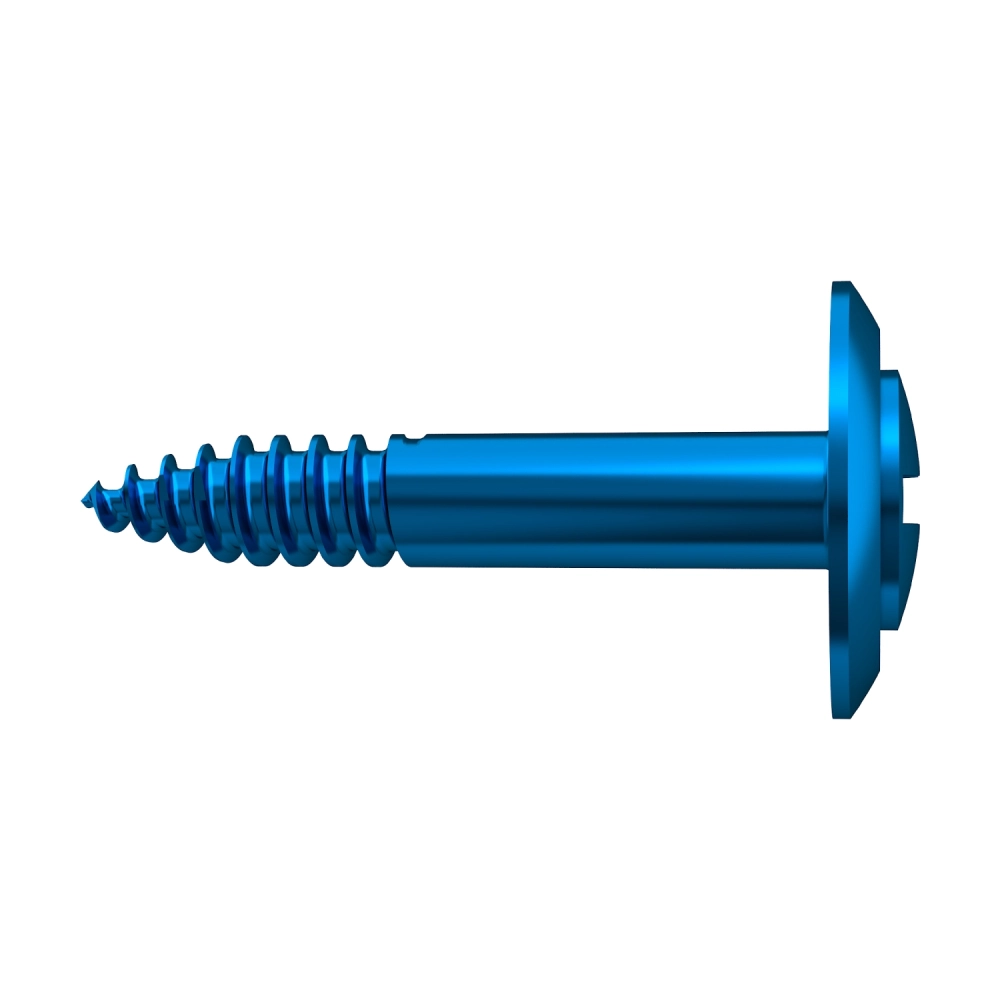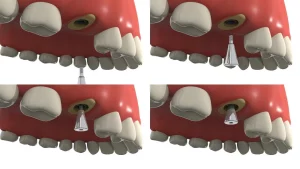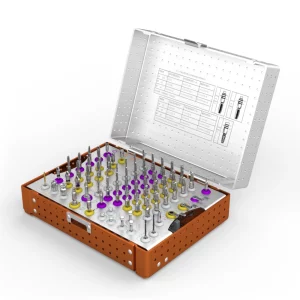In contemporary dental implantology, dental tenting screws are essential instruments, especially for bone grafting operations. These screws are intended to provide stability and support during the bone-regeneration process, particularly in situations where there has been a substantial loss of bone. They are essential to Guided Bone Regeneration (GBR) procedures, which replace lost bone volume by filling bone defects with autogenous or synthetic graft material.
Tenting screws are tiny, self-tapping screws that are placed into the bone around the graft site. They are composed of materials like titanium or resorbable polymers. Their main function is to stabilise the bone graft material so that bone may grow back in places where there isn’t enough volume for the right implant placement.
The reader is introduced to the purpose and significance of dental tenting screws in this section. Their function is particularly crucial in cases when patients who need dental implants need bone grafting because their bone is either lacking or inadequate. Bone grafts may move or fail to integrate without this stabilisation, which might cause issues when the wound heals.

Understanding the Role of Tenting Screws in Bone Grafting
Patients who have lost bone as a result of illness, trauma, or tooth extraction often need to have bone grafting done. Because dental implants need a certain quantity of healthy bone to attach effectively, this loss may make them less successful. In these situations, the lost bone is replaced using bone grafting materials, such as autogenous bone, allograft, xenograft, or synthetic bone replacements.
However, since these materials may move, migrate, or even fail to integrate with the surrounding bone, they must be stabilised during the healing process. Tenting screws, which hold the graft material in place, are essential to resolving this issue.
Tenting screws aid in preventing migration and offer a stable environment for the bone graft to heal correctly by enclosing it in a temporary, secure scaffold. By lightly pressing on the graft material and the surrounding bone, the screws provide room for new bone to develop. New bone may grow in the grafted region as a result of this pressure and the regeneration process.
How Tenting Screws Work in Bone Grafting
Dental tenting screws work in a comparatively simple yet very efficient manner. The surgeon will put one or more tenting screws into the surrounding bone after placing a bone transplant. The graft material is held in place by the lateral compression that these screws’ precise placement provides.
Tenting screws are often introduced via tiny incisions and are designed to be as little intrusive as possible. The screws themselves are not always in place. The screws are often resorbable, which means that when the bone transplant integrates and new bone grows, they will eventually disintegrate. After the graft has completely integrated, non-resorbable screws—like titanium ones—must be taken out.
A stable microenvironment for the graft material is facilitated by the introduction of tenting screws. When the available bone volume is insufficient to support dental implants, they essentially provide mechanical stabilisation for bone augmentation treatments such as sinus lifts and ridge augmentations.
Types of Tenting Screws for Bone Grafting
Dental tenting screws come in two main varieties: resorbable and conventional (non-resorbable). Although both kinds perform comparable tasks, there are some significant distinctions that dictate how they are used in therapeutic contexts.
- Conventional Tenting Screws
Titanium and other sturdy metal are often used to make traditional tenting screws. Titanium is the perfect material to utilise in the mouth since it is biocompatible, which means the body does not reject it. After the bone transplant has completely integrated, these screws are taken out of the socket. Titanium screws can tolerate the strains of the healing process and provide exceptional mechanical support and longevity.
Advantages of conventional screws:
High durability and strength
Biocompatibility with low rejection risk
Capacity to endure the strains of the recovery process
- Tenting screws that are resorbable
Biocompatible materials such as polylactic acid (PLA) or polyglycolic acid (PGA) are used to make resorbable tenting screws. Over time, these substances disintegrate, removing the screws without the need for a second surgical treatment. When the bone transplant is not anticipated to need long-term support, resorbable screws are usually used.
Advantages of resorbable screws:
- After the graft cures, removal is not necessary.
- decreased risk of complications and patient discomfort
- Postoperative care that is faster and easier
- Both kinds of screws have their applications, and the size of the bone defect, the anticipated healing period, and the patient’s medical background all play a role in the decision.
Tenting screw indications for dental bone grafting
Tenting screws are recommended in a number of situations where effective implant placement requires bone regrowth. These situations consist of:
- Lifts for the sinuses
Sinus lift surgery is often done on individuals who have inadequate bone in their upper jaw, particularly in the posterior maxilla. The sinus membrane is raised during this treatment, and bone graft material is applied to the affected location. The graft is stabilised and kept from moving throughout the healing process with the help of tenting screws. - Augmentation of Ridges
When the mandible (lower jaw) or maxilla (upper jaw) lack bone to support implants, ridge augmentation is required. While new bone grows, the bone graft material is held in place with the use of tenting screws. - Bone Deficiencies Horizontal and Vertical
Tenting screws may be utilised to stabilise the grafts and generate space when the volume of bone is insufficient in both vertical and horizontal dimensions. This allows for more predictable implant placement.
When GBR (Guided Bone Regeneration) treatments are utilised if there is a considerable bone deficit, tenting screws are very helpful. By using them, you can make sure that the bone transplant stays in place and doesn’t move or collapse as it heals.
Tenting screws provide the following benefits when used in dental surgery:
1. Increased Graft Stability
Tenting screws’ main advantage is that they provide the bone graft material more rigidity. This is essential to guarantee that the graft stays in situ during the healing process and properly fuses with the surrounding bone.
- Reduced Complications
Tenting screws lower the chance of issues like infection or transplant failure by avoiding graft displacement. As a result, dental implant and bone grafting treatments have a better success rate. - Cost-Effective
By lowering the need for subsequent corrective operations or treatments, the usage of tenting screws may ultimately result in financial savings. They are thus an affordable option for implant and bone grafting treatments.
A Comprehensive Guide on the Use of Tenting Screws in Bone Grafting Techniques
The following stages are often included in the use of tenting screws in bone grafting:
Step 1: Pre-Surgical Planning
The patient’s health, the kind of bone transplant needed, and the overall surgical strategy will all be evaluated by the surgeon prior to surgery. The size and location of the bone defect determine whether tenting screws are used.
Step 2: Placement of Tenting Screws
To reach the bone transplant location, the surgeon will make tiny incisions throughout the procedure. The graft material is subsequently stabilised by securing it with tenting screws. To prevent harm to the surrounding tissues, these screws are inserted precisely.
Step 3: Bone Graft Placement
The bone graft material is carefully inserted into the surgical incision when the screws are in place. As new bone forms, the screws aid in keeping the transplant in place.
Step 4: Post-Surgical Care
The patient is given post-operative care instructions and the incision is closed after the transplant is in place. Managing discomfort, refraining from certain activities, and keeping follow-up visits to track the healing process are a few examples of these suggestions.
Risks and Challenges of Tenting Screws in Bone Grafting
Despite their overall effectiveness and safety, tenting screws come with some risks:
- Infection: There is a chance of infection with each surgical operation.
- Failure of Bone Graft: The graft may not integrate well in rare circumstances, necessitating further operations.
- Screw Migration: Tenting screws may migrate or shift if they are not positioned correctly, which might have an impact on how well the bone grafting surgery goes.
Postoperative Care and Healing Process
To guarantee that the bone transplant heals properly, the patient will need to adhere to certain recommendations after the treatment. This might include staying away from tough meals, taking prescription drugs as directed, and going to follow-up sessions to track your improvement.
Case Study: GBR Tenting Technique Surgery for Missing Tooth #11
Clinical Overview
A patient presented with a missing tooth #11 (upper right central incisor) and was seeking treatment to restore the area for future implant placement. During the oral examination, it was observed that the alveolar ridge in the area was insufficient for immediate implant placement. Specifically, the width of the ridge was narrow, and there was a vertical depression on the labial side of the ridge, further compromising the area for bone grafting.
Pre-Surgical Assessment
- Bone Deficiency: The patient’s alveolar ridge lacked sufficient width and height for a stable implant placement. The bone defect was most prominent on the labial side of the ridge, where the depression created a challenge for maintaining graft material and supporting new bone growth.
- Vertical Defect: A noticeable vertical depression was identified on the labial side, which was contributing to the insufficient bone height and making the site unsuitable for conventional implant placement without augmentation.
Surgical Plan and Approach
After reviewing the patient’s condition, it was determined that a Guided Bone Regeneration (GBR) technique would be the best approach to regenerate the bone and prepare the site for future implant placement. The procedure was planned as follows:
- Bone Grafting: A bone graft would be used to fill the defect and restore the necessary bone volume to the site.
- Tenting Screw Placement: A 1.6 x 10 mm tenting screw was indicated to stabilize the bone graft and prevent shifting during the healing process. The screw was strategically placed in the vertical depression to stabilize the graft material.
- Tissue Flap Elevation: A small incision would be made to elevate the gingival tissue and expose the underlying bone for grafting.
For more information, please click: Tenting Screws Clinical Cases
Conclusion: The Future of Tenting Screws in Bone Grafting
For dental implant and bone grafting procedures to be successful, tenting screws are essential. They have transformed dental operations by stabilising bone graft material throughout the healing process, resulting in less problems and more predictable results.
Future developments in implant technology and biocompatible materials will further enhance tenting screws’ performance, increasing their efficacy in a variety of bone regeneration techniques.





